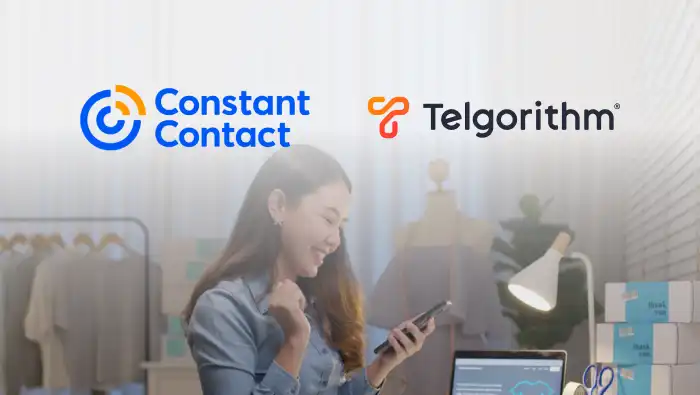BLOG POST
Published: February 05, 2024
What You Need to Know About A2P 10DLC Rate Limits
Written by: Telgorithm Expert

What Are 10DLC “Rate Limits”?
There are a few interchangeable words that are used to describe the number of application-to-person (A2P) 10-digit long code (10DLC) text messages that a business is able to send within a specific time period: rate limits, throughput limits, and volume limits are all examples. In this article, we’re going to use “rate limits”.
On the person-to-person (P2P) text messaging pathway, there’s an umbrella rate limit of 60 texts per minute (TPM) per number. When you and a friend are texting each other back and forth, you’re using the P2P pathway, and it’s highly unlikely that you’d need to (or even be able to) send more than 60 messages to each other in one minute.
As a business, on the other hand, 60 MPM is almost certainly too low, regardless of the message use-case (e.g. marketing, 2FA, delivery notifications, etc.). The A2P pathway was created to enable businesses to send higher volumes of messages within a specific time period, AKA higher rate limits, but is regulated by Carriers to help mitigate SPAM and other bad actors.
How Are My 10DLC Rate Limits Determined?
North American Carriers are responsible for setting 10DLC rate limits across all A2P text messaging use-cases. These are determined for businesses through 10DLC registration with The Campaign Registry (TCR), the “reputation authority” for 10DLC.
TCR registration is similar to doing a background check. You provide the required information on a business (Brand) and its text messaging use-case (Campaign) which is then used to vet and verify the business and its messaging needs. If everything checks out, the Carriers reward you with higher messaging rate limits, less filtering, and lower Carrier pass-through fees.
Here’s where things start to get more complicated – each Carrier allocates rate limits differently as they each have different perspectives in regards to throughput limitations. Let’s take a look at the three largest Carriers in North America:
- Verizon: allocates by the number of messages sent per phone number per minute
- AT&T: allocates by the number of messages sent per Campaign per minute (regardless of the amount of numbers assigned to a Campaign)
- T-Mobile: allocates by the number of messages sent per Brand per day (regardless of the amount of Campaigns and their associated numbers)
What this means is that in order to maximize your rate limits without exceeding them, you need to proactively know who each message recipient’s Carrier is and how many messages are being sent to each Carrier from the Brand and its related Campaigns prior to sending a text message.
What Happens If I Exceed My Rate Limits?
This will result in dropped or blocked messages, or worst case scenario, a Brand or Campaign suspension. This depends on your SMS API provider, but on top of dealing with an SMS/MMS disruption, you’re likely still being charged for those undelivered messages plus Carrier pass-through fees.
Can I Increase My Rate Limits?
If you have compliant Campaigns that legitimately need higher rate limits, you can work with your SMS API provider to apply for added vetting to raise your ceiling. The question is, do you really need it?
Error Codes for Exceeding Rate Limits
If you have been receiving error codes for exceeding Carrier rate limits, here are a few things you should ask your provider:
- Are you looking up all of my Campaign recipients’ Carriers ahead of sending out the messages?
- If you are, what kind of process is in place for managing how messages are sent to each with respect to my rate limits?
- If you do manage rate limits, why am I receiving error codes for exceeding those limits? Why would you even need such error codes?
Your provider may tell you that you are responsible for performing these lookups and managing rate limits for your SMS/MMS customers.
Three Approaches to Rate Limit Management
At Telgorithm, we’re aware of three different approaches SMS API providers have in place to manage these Carrier rate limits for 10DLC.
- Capping – It’s as bad as it sounds. To avoid exceeding rate limits, providers will set a cap based on the lowest rate limit across all Campaigns associated with one Brand. You won’t exceed limits, but you also lose out on your investment in registration for higher rate limits and may have Campaigns that are drastically limited.
- Lifting the Ceiling – We don’t have a better word for it, but this represents when a provider enables messages to flood out with no management whatsoever. This is how T-Mobile’s daily cap is typically handled, and why there are so many delivery issues on T-Mobile (do error codes 30023, 40016 or 4780 look familiar?).
- The Telgorithm Way – Cheesy, we know. But we have a high tech system in place for proper rate limit management that enables your messages to send at max rates across all Brands and associated Campaigns without ever exceeding your limits. Our customers send millions of messages with our APIs each month and have an average deliverability rate of 99%+.
Telgorithm’s Rate Limit Management for 99%+ Message Deliverability
Our messaging API is stacked with amazing product features developed especially for these nuanced 10DLC messaging needs. Before any messages are sent, our technology automatically looks up and tracks each recipients’ Carrier and the approved Carrier rate limits across all Campaigns under the Brand. Here’s where the features come in:
- Queueing Alerts: If a Brand or Campaign is nearing its rate limits due to list size growth, increased messaging traffic, etc., instead of receiving an error code, Telgorithm sends a Queueing Alert to let you know you should proactively start applying for added vetting.
- Smart Queueing: If your Campaign does hit its rate limits, this feature will hold any messages that would have gone over to avoid any dropped or blocked messages. The messages will then be released when the rate limit refreshes.
- Time Routing: We’re all about proactivity. Our Time Routing features gives you more control over what happens to messages that do end up in the queue. You can schedule them to send at a specific time rather than right when the rate limits refresh (which may not be optimal times for the recipient).
- Message Cancellation/Expiry: Prior to sending a message, you can dynamically set an expiration time. For example, if there is a time-sensitive message that will no longer be relevant after a certain time, the message will be canceled/expired (Telgorithm doesn't charge for Canceled/Expired messages).
- Message Prioritization: There could be high priority Campaign use-cases under a Brand that should always take precedence over lower priority Campaigns. With Message Prioritization, you can ensure those Campaigns are always sent out first so that they may not end up in the queue.
Deliverability = Savings
Good text message deliverability is essential for your app or software customers’ ROI, but it also means higher cost savings for you. With other providers you pay for every message sent – even if it drops. Telgorithm’s APIs will not allow messages to drop due to exceeding your Carrier rate limits. We have found that approximately 10% of our customers’ text messages are queued with Smart Queueing each month. These are clean, registered, fully compliant Campaigns that eventually hit Carrier rate limits – a common occurrence when you’re sending millions of messages each month.
If our customers were with a provider that did not manage their rate limits, around 10% of their traffic would be undelivered due to hitting limits, then re-sent, resulting in 2x payments for the same messages (plus Carrier pass-through fees).
No dropped messages = no paying double to get texts delivered. That’s how Smart Queueing saves Telgorithm customers 10% of their traffic costs. For example, that's $27K annually if you send 5M messages a month on average.
Telgorithm is the leading CPaaS for 10DLC SMS APIs for a reason. Schedule a demo to learn more.
Latest news
Subscribe to our newsletter.
Navigate the cloud communications world with knowledge. Subscribe to our blog newsletter to receive the latest industry news, tips, and guidance.
By clicking the submit button below, I hereby agree to and accept Telgorithm’s terms and conditions.


